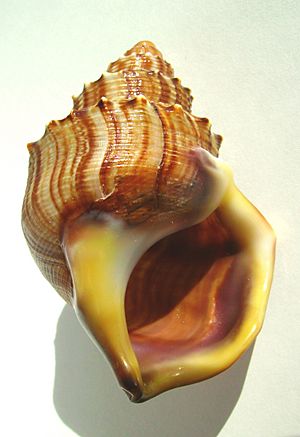Ostrich foot snails facts for kids
Quick facts for kids Struthiolaria |
|
|---|---|
 |
|
| An apertural view of a shell of the ostrich foot, Struthiolaria papulosa |
|
| Scientific classification | |
| Kingdom: | |
| Phylum: | |
| Class: | |
| (unranked): |
clade Caenogastropoda
clade Hypsogastropoda clade Littorinimorpha |
| Superfamily: |
Stromboidea
|
| Family: |
Struthiolariidae
|
| Genus: |
Struthiolaria
Lamarck, 1816
|
| Type species | |
| Struthiolaria nodulosa Lamarck, 1816 |
|
| Species | |
|
See text |
|
| Synonyms | |
|
|
Struthiolaria, often called ostrich foot snails, is a group of sea snails. These amazing creatures are marine gastropod molluscs. They belong to a family called Struthiolariidae. You can find them living in the ocean, often on sandy or muddy seabeds.
Contents
What are Ostrich Foot Snails?
Ostrich foot snails are a type of snail that lives in the sea. They are part of a larger group of animals called molluscs. This group also includes clams, oysters, and octopuses. Snails like Struthiolaria have a hard shell to protect their soft bodies.
Why are they called "Ostrich Foot"?
The name "ostrich foot" comes from the shape of their foot. When these snails move, their foot can look a bit like an ostrich's foot. This is how they get around on the ocean floor. They use their strong foot to glide over sand or mud.
Where do Ostrich Foot Snails Live?
Most Struthiolaria species live in the Southern Hemisphere. You can find them in places like New Zealand and parts of South America. They prefer cooler waters. They live on the seabed, often in areas with soft sand or mud. This allows them to move easily and find food.
What do Ostrich Foot Snails Eat?
Ostrich foot snails are filter feeders. This means they eat tiny bits of food floating in the water. They use special parts of their body to filter out small plankton and other organic particles. It's like they are sifting the water for their meals!
Types of Ostrich Foot Snails
The Struthiolaria group includes several different species. Some of these species are still alive today. Others are known only from fossils. Scientists use these fossils to learn about Earth's past. They help us understand how life has changed over millions of years.
Here are a few examples of species in this group:
- Struthiolaria papulosa
- Struthiolaria ameghinoi
- Struthiolaria frazeri
Many other species are known only from fossils. These extinct species help scientists trace the history of these snails.

